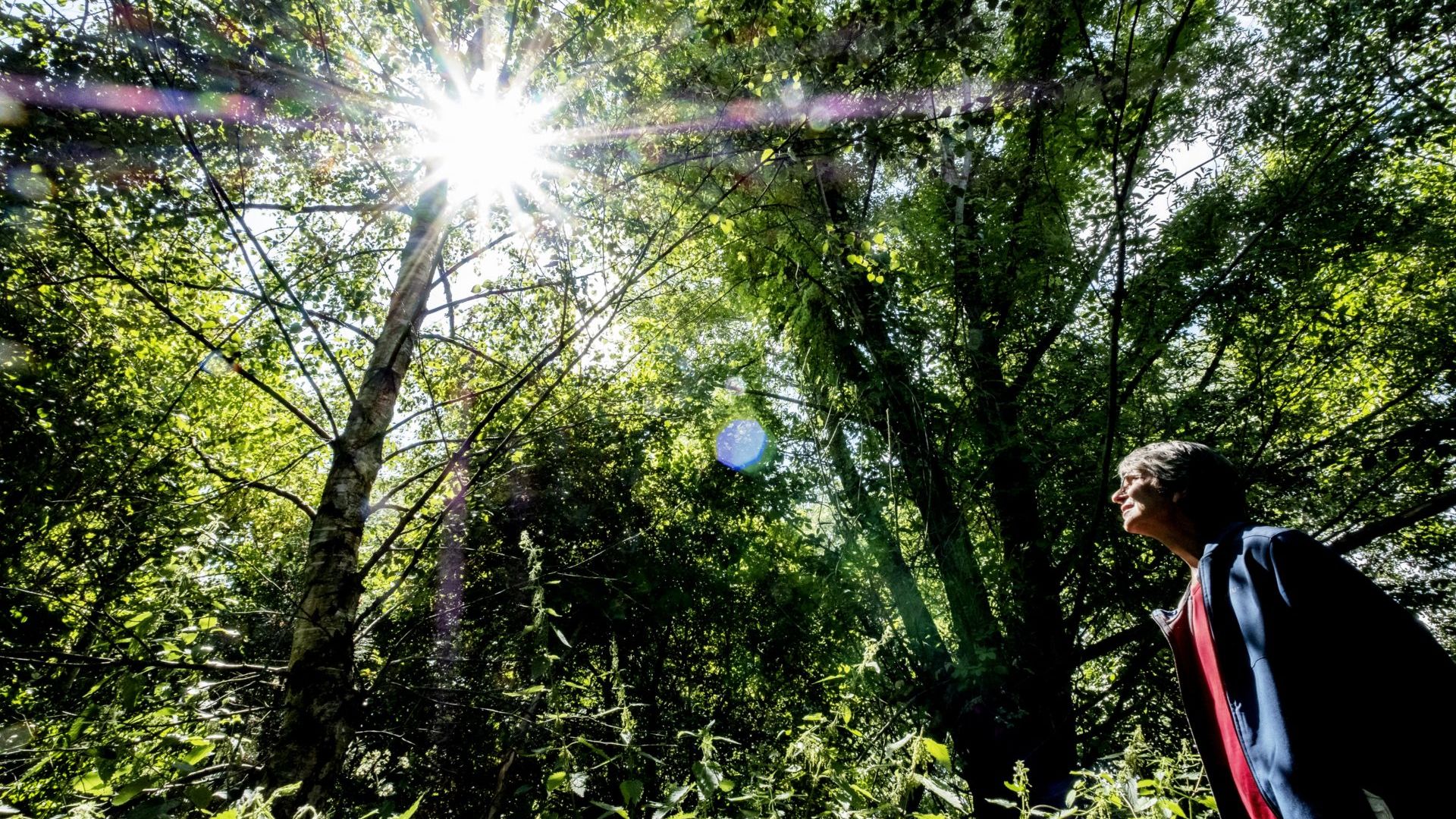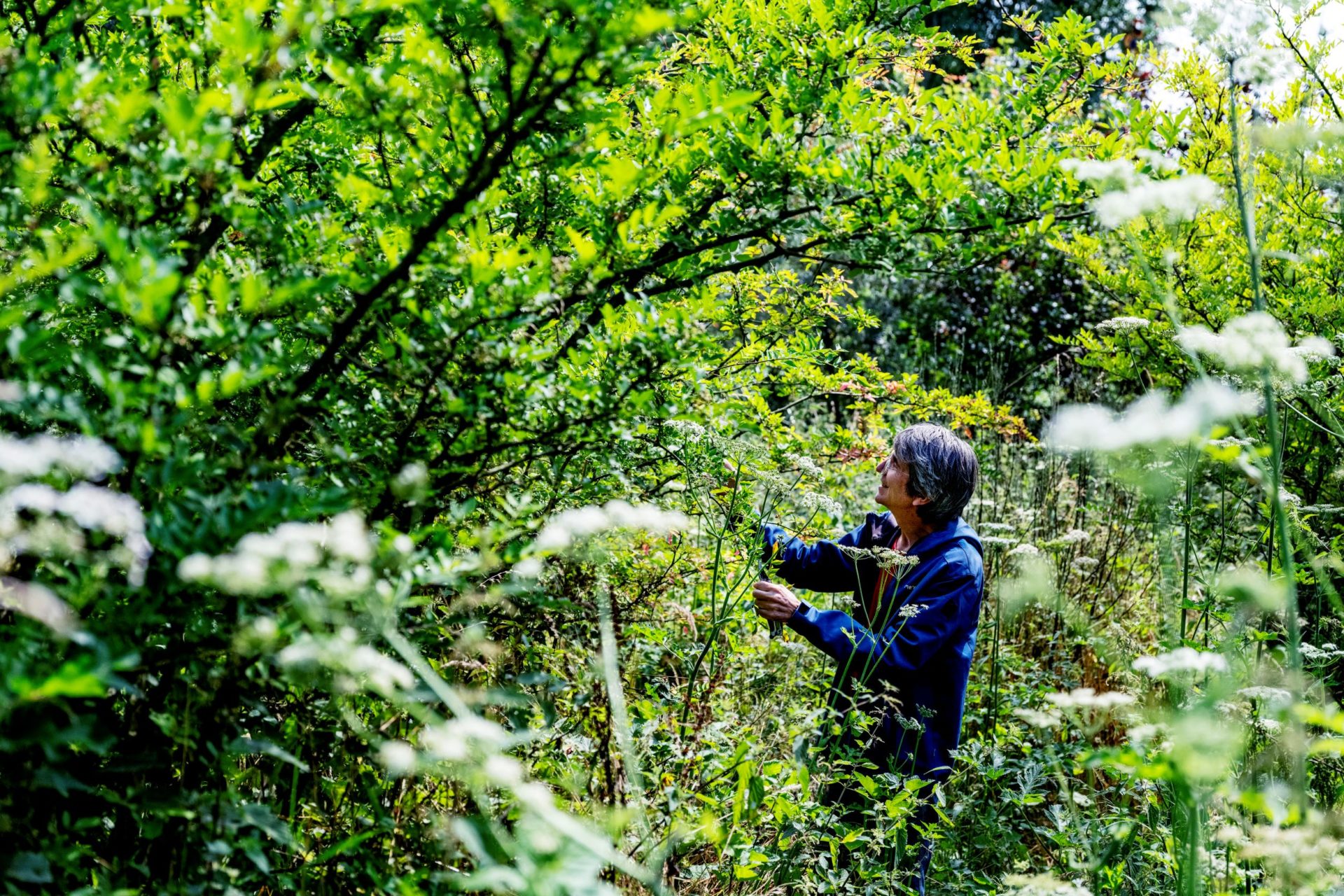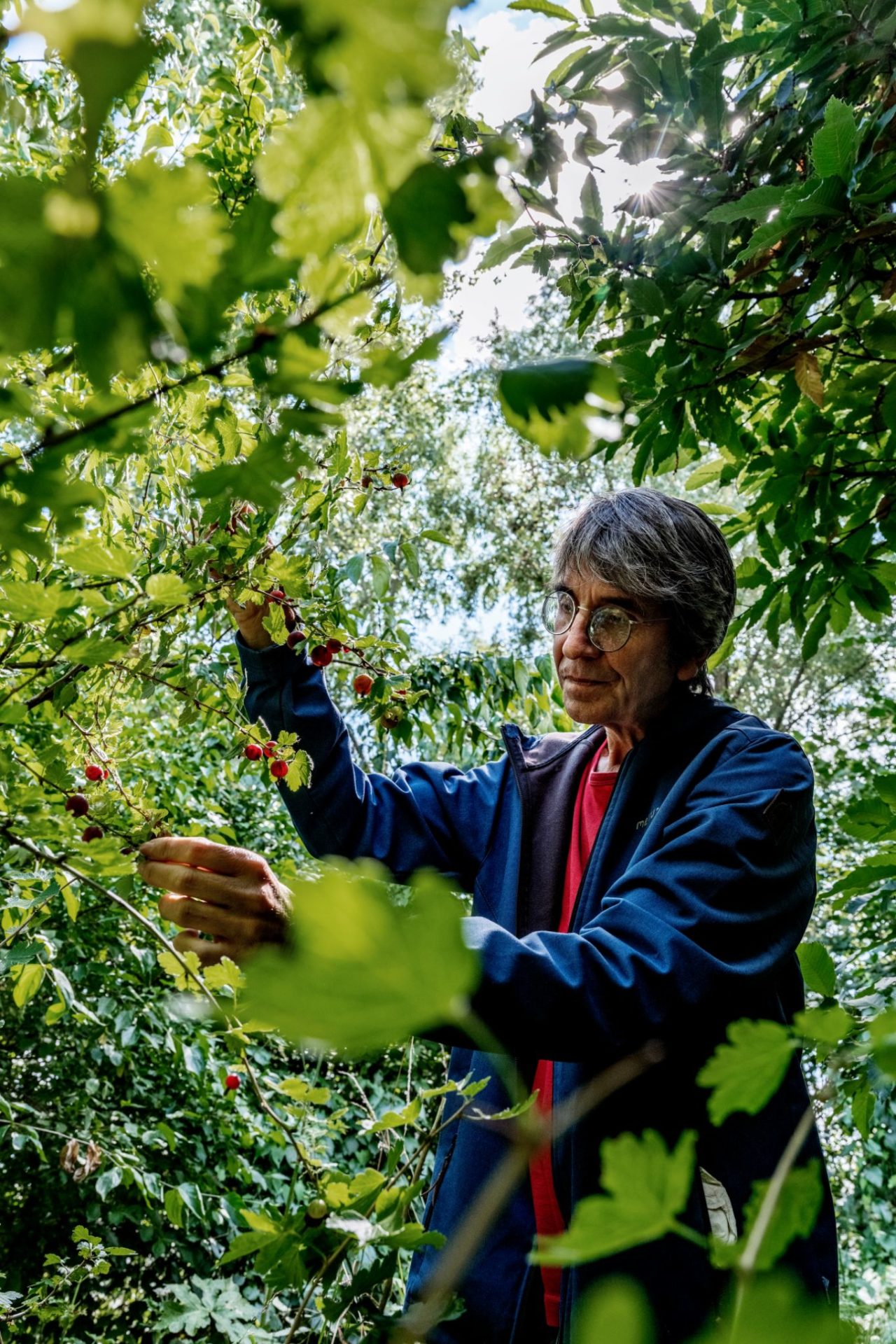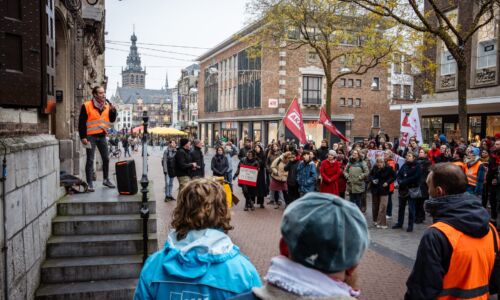Summer interview (end): Food forest pioneer Wouter van Eck does see a future for farmers
-
 Wouter van Eck in zijn voedselbos. Foto: Duncan de Fey
Wouter van Eck in zijn voedselbos. Foto: Duncan de Fey
Wouter van Eck has opposed the use of fossil fuels and the depletion of Earth's natural resources almost all his life. This politician and activist from Nijmegen set up Ketelbroek community food forest in 2009. By now, it’s the best-known of its kind in the Netherlands. Now that farmers are angry and The Hague at its wits' end, he believes a breakthrough is imminent.
Wouter van Eck is not an angry farmer. Wouter van Eck is a happy farmer. He’s even able to laugh about his failures. Years ago, he planted the Canadian high bush cranberry in his food forest in the village of Groesbeek. ‘But the fruit always tastes like the smell of dog poo. Even Emile can do nothing with it.’
Two-star restaurant
Emile is Emile van der Staak, the chef who was recently awarded a second Michelin star for his restaurant in Nijmegen – De Nieuwe Winkel. Emile is well-known for the gastronomic gems he is able to produce with vegetables and fruit (many of them little known). The chef can be found in Wouter van Eck’s food forest every Monday; they have collaborated for years. ‘Emile is passionate about telling his story, that a plant-based diet is the diet of the future and that it’s really delicious too. It’s no punishment, saving the world.’
So the two-star chef is an excellent ambassador for the food forest. And the current crisis surrounding nitrogen might even prove to be beneficial for farmers who are focusing on cultivating trees and shrubs that don’t place stress on nature. In other words: Wouter van Eck is swimming with the tide.
Food forest
In a food forest, there are trees of varying heights. On the ground, food-producing bushes and plants grow. Berries and rosehips, for example. Herbs and climbing plants are also planted. It’s possible to harvest from the various crops almost all year round. The forest forms its own ecosystem and provides shelter for birds and insects. The longer the forest is allowed to grow – left in peace by people – the greater the yield.
That was not the case in 2009. Eck, who graduated in political science from Radboud University in 1989 and was both acclaimed and reviled eighteen years ago for his radical plan to ban SUVs from the centre of Nijmegen – was Chair of the GroenLinks party (green party) at the time – and his partner bought a piece of land in Groesbeek. It had once been a bare maize field, with completely depleted soil. He planned to turn it into the first food forest in the Netherlands. ‘That idea had been simmering in my mind since my student days’, he explains, striding in blue wellies past immense willow trees. ‘I didn’t really have an example to follow, so I just started.’
Green beans
Van Eck was unafflicted by any experience of agriculture. His father wasn’t a farmer but a teacher. And my mother grew up in an upstairs house next to Kronenburger Park. She couldn’t tell an apple tree from a pear tree.’ But van Eck had always had a great love of nature and outdoor life. As a child, he and his parents had lived in the Achterhoek region. ‘My mother says that even as far back as that, I said I wanted to be a farmer. To which she said that I should start by eating green beans, which I didn’t like, because that was what real farmers did.’
He’s learned to like them in the meantime. But he doesn’t grow them in his food forest. It’s not a vegetable garden. He laughs. ‘I’m far too lazy to have a vegetable garden. The great thing about a food forest is that you hardly have to do anything with it.’ Van Eck plucks a leaf. ‘Want to taste it? This is ordinary hogweed. In Iran, they use it as a vegetable. Some people find the flavour a bit too strong; it tastes a bit of citrus fruit.. But the flavour is milder if you stir-fry it.
Wouter van Eck considered studying biology when he left secondary school but opted for political science in the end. He was socially active – that was something he did learn from his parents – and set off for the left-wing city of Nijmegen. There, in the Thomas van Aquinostraat, the first seed of his own food forest was planted and later, the food forest foundation – Stichting Voedselbosbouw.
‘I decided to do a free doctorate, which was a curriculum you were allowed to put together yourself. By that time, I was already spending time at the Third World Centre at the university and was convinced that we were at a dead end as far as the development of societies based on consumption of fossil fuels, finite supplies of raw materials and intensive farming were concerned. I wanted to look at how we should develop in that case, with a view to nature conservation. So I took subjects at Wageningen University too.’
Power structures
The young Van Eck took classes with the legendary Gerrit Huizer, director of the Third World Centre, prominent beard-wearer and famous for his book (Peasant Unrest in Latin America, 1973) about the way small-scale farmers in El Salvador were the victims of the existing power structures. Van Eck travelled to Kenya for a field internship to research Dutch development projects.
Interview series
This is the last chapter in a series of summer interviews. Most articles were also published in our paper Vox, which you can find in special magazine boxes around campus and in the city centre.
‘Dutch people were working there like a kind of missionaries to modernise agriculture with Dutch funding. Classically educated engineers from Wageningen University introduced hybrid maize seed which, in ideal circumstances, produces a good yield. But you can’t use the seed again the year after, so the local farmers had to keep buying it. It’s a trick to make money. For thousands of years before that, Kenyan farmers used more sustainable seed. Plus they planted lentils between the rows of maize because lentils bind the nitrogen so that you don’t have to go buy it elsewhere in the form of artificial fertiliser. Thanks to the programme introduced by the Dutch, the Kenyan government forbade that form of crop mixing and farmers were made dependent on loans, artificial fertiliser and hybrid maize seed.’
Van Eck shakes his head. Even as a naive student from Nijmegen, he could see that this could only end badly. The intended successes were based on Dutch summers in the 1980s. In extreme drought, the yield would be disappointing and in heavy rains, the entire monoculture would be washed from the slope. But there were toxic interests concerned: those of greedy suppliers and power-hungry policy makers. The local farmers could stand by and look. It’s no great leap from that to the current crisis surrounding nitrogen in the Netherlands.
Philosophy
‘The agriculture missionaries got a bit irritated by my criticism and at a certain point, I hiked to the other side of the valley. There I came across the ultimate luxuriant food forest avant la lettre. I was amazed at the multitude of edible crops: papaya, mango, avocado. In the layer below, there were banana plants and yet another layer down, even coffee, tea and other plants that prefer not to be in bright sunlight.’
Van Eck recalls the chirping of birds and buzzing of insects, exactly the sounds heard during a walk through his own food forest in Groesbeek. He stored all this information in a corner of his mind, knowing that when the time was right, it would emerge again. And that happened during his years as a lecturer at Radboud University and during his dual function as campaign leader for Milieudefensie and municipal councillor for GroenLinks.
‘Look,’ he says as a frightened honey buzzard flies up in front of his feet, ‘There are apple and nashi pear trees here. We can harvest between mid-August and October. Earlier in the year, birds nest under them but they’re gone by the time we come to pick the fruit.’
The main philosophy behind a food forest is that nature and agriculture need not get in each other’s way. But in the traditional rural Netherlands, the two are constantly in each other’s way. Van Eck gives an example: near here is De Bruuk nature reserve, which has been a pearl of the nature preservation movement since the 1930s, with its vulnerable orchids, gentians and marsh lousewort. A line was drawn on the map and precisely on the other side is an agrarian company that injects fertiliser and uses pesticides. Both parties are subsidised by the government. ‘That’s just insane. Now, with the crisis surrounding nitrogen, there finally seems to be some acknowledgement of just how strangely we have organised this in the Netherlands.
Alternatives
Van Eck is not in any way advocating that all farm businesses that rub shoulders with nature reserves should disappear. But they should farm differently, in a way that places less stress on the environment. And yes, a food forest is one option. ‘That doesn’t mean that that one specific farmer has to reinvent their business; they might want to let themselves be bought out and then another farmer can set up a food forest at that location.’
The lack of creativity at the Ministry of Agriculture irritates him; they don’t seem to be able to get much further than ‘keep the farmer’ or ‘get rid of the farmer’ in The Hague. And that results in burning hay bales on the motorway and tractors blocking traffic. However, he also feels that the farmers let it happen. ‘The environmental movement and the Club of Rome already warned us fifty years ago about the consequences of economic growth for the environment. They’ve been proved right; scaling up continued and now we’re in big trouble. And it seems as though farmers complain every two months that it’s either too dry or too wet. You do know by now that the climate is changing, right?’

What works better, according to him, is making the alternatives visible. For example, he recently met with the extremely sceptical Caroline van der Plas (BoerBurgerBeweging) in his food forest after she had made disparaging remarks on Twitter about his form of agriculture in a new food forest in Schijndel. He invited her to come and see for herself and gave her a guided tour upon which she took back what she had said. He sees that as one of his major tasks as a pioneer of food forests: showing that it works.
Is it viable for making a living? Not yet. ‘A food forest has a long lead time. But after fifteen to twenty years, it can yield 15,000 euro per hectare. That’s much more than a hectare of silage maize or potatoes. Not only that, but the productivity and yield increase with each year.’ His piece of land is only 2.4 hectares, which isn’t much. He recommends that farmers who are interested in a food forest start with 5 hectares. With his foundation, he has succeeded in getting agricultural entrepreneurs the same subsidy for a hectare of food forest as for a hectare of other crops. ‘This is to emphasise the fact that it’s not a hobby as well.’
The way of farming is completely different: after planting, you actually don’t have to do a thing – no spraying, fertilising or ploughing – and farmers are not used to that. ‘I regard food forests not so much as a complete replacement of old-fashioned agriculture, but as a supplement for it. Obviously, we would still have to grow potatoes.’
Chocolate mousse
Chef Emile van der Staak is around to demonstrate what you can cook with the new crops. He makes ketchup from hawthorn berries and chocolate mousse from chestnuts – trees that can live for 450 years. Van Eck, licking his lips: ‘That’s just brilliant. Of course we can’t produce that in our own kitchens yet but in the long term, the process can be standardised so that a product can be found on supermarket shelves in the end.’
Call him an idealist, but this vegetarian firmly believes that the idea of food forests approaches the tipping point. With his foundation, he aims to realise another 170,000 extra hectares of food forest in the coming ten years: at present, there are 300. To put this into perspective: there are 2.2 million hectares of agricultural land in the Netherlands. Compare us to the hippies of the 1970s who started messing about with windmills. A lot of them failed, because not all eco-anarchists were equally skilled but in the end, the windmill industry has become a large and significant business. It allows you to switch your highly technological society over to sustainable energy.’
Wouter van Eck’s optimism remains undiminished. A few years ago, he moved from Nijmegen to Groesbeek and now he can just walk to his forest (it goes without saying that the man who coined the phrase Havana on the Waal as a nickname for Nijmegen has no car. Something he visibly enjoys. ‘The system doesn’t need me but I need the system. I’ve become so attached to it now that if three days go by without my having visited the forest, there’s a kind of hole in my mind.’
About Wouter van Eck
In 2004, Wouter van Eck (1965) had the dubious honour of calling himself one of the most threatened politicians in the Netherlands. On behalf of the GroenLinks party, he had convinced Nijmegen municipal council to ban SUVs from the city centre. Angry car lovers responded by taking out life insurance in his name, for example. The police was really concerned for his safety when the left-wing activist Louis Sévèke, with whom Van Eck worked, was murdered (no suspect was identified at the time). Van Eck also lobbied successfully as municipal councillor and Chair of GroenLinks to prevent Flash Gordon, a controversial plan for a multi-storey car park and tower flats in the historic town centre. Other achievements include scrapping the controversial MTC transshipment centre near Valburg in the Betuwe region and the abandoning of the plan to extend the A73 motorway through the river landscape near Weurt and Oosterhout. He christened Nijmegen ‘Havana on the Waal’ in 2002, when the coalition government consisted wholly of left-wing parties for the first time.
In 2007, he spoke at a plenary in the House of Representatives as the first submitter of a citizens’ initiative. He was representing more than 105,000 co-submitters. The citizens’ initiative – ‘Stop Dishonest Meat’ – was set up by Milieudefensie and advocated halving the Dutch livestock population, introducing a tax on meat and support for farmers who switch to sustainable production methods. These plans were supported only by GroenLinks, D66 and Partij voor de Dieren. Wouter van Eck has been Chair of Stichting Voedselbosbouw Nederland since 2016.




